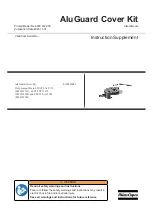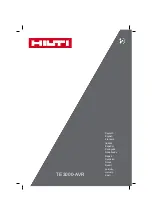
6
d)
Store idle power tools out of the reach of children and
do not allow persons unfamiliar with the power tool or
these instructions to operate the power tool.
Power
tools are dangerous in the hands of untrained users.
e)
Maintain power tools. Check for misalignment or
binding of moving parts, breakage of parts and any
other condition that may affect the power tool’s
operation. If damaged, have the power tool repaired
before use.
Many accidents are caused by poorly
maintained power tools.
f)
Keep cutting tools sharp and clean.
Properly
maintained cutting tools with sharp cutting edges are less
likely to bind and are easier to control.
g)
Use the power tool, accessories and tool bits etc.,
in accordance with these instructions, taking into
account the working conditions and the work to be
performed.
Use of the power tool for operations different
from those intended could result in a hazardous situation.
5) SERVICE
a)
Have your power tool serviced by a qualified repair
person using only identical replacement parts.
This
will ensure that the safety of the power tool is maintained.
SAFETY INSTRUCTIONS FOR MULTI-FUNCTION
TOOLS
GENERAL
• This tool should not be used by people under the age of
16 years
• Use completely unrolled and safe extension cords with a
capacity of 16 Amps (U.K. 13 Amps)
• Always check that the supply voltage is the same as the
voltage indicated on the nameplate of the tool (tools with
a rating of 230V or 240V can also be connected to a
220V supply)
• Avoid damage that can be caused by screws, nails and
other elements in your workpiece; remove them before
you start working
•
Secure the workpiece
(a workpiece clamped with
clamping devices or in a vice is held more securely
than by hand)
•
Do not work materials containing asbestos
(asbestos
is considered carcinogenic)
• Always disconnect plug from power source before
making any adjustment or changing any accessory
• When working, always hold the tool firmly with both
hands and take a secure stance
• Always keep the cord away from moving parts of the tool;
direct the cord to the rear, away from the tool
•
Use protective gloves when changing accessories
(contact with the accessory can lead to injuries)
• In case of electrical or mechanical malfunction,
immediately switch off the tool and disconnect the plug
• If the cord is damaged or cut through while working, do
not touch the cord, but immediately disconnect the plug
• Never use the tool when cord is damaged; have it
replaced by a qualified person
• When you put away the tool, switch off the motor
and ensure that all moving parts have come to a
complete standstill
WHEN SAWING/CUTTING
•
Hold power tool by insulated gripping surfaces,
when performing an operation where the cutting
accessory may contact hidden wiring or its own
cord
(a cutting accessory contacting a “live” wire may
make exposed metal parts of the power tool “live” and
could give the operator an electric shock)
•
Keep hands away from cutting area
; never reach
underneath the material for any reason while cutting
•
Use suitable detectors to find hidden utility lines or
call the local utility company for assistance
(contact
with electric lines can lead to fire or electrical shock;
damaging a gas line can result in an explosion;
penetrating a water pipe will cause property damage or
an electrical shock)
• Do not use a saw blade which is cracked,
deformed or dull
WHEN SANDING
• Dust from material such as paint containing lead, some
wood species, minerals and metal may be harmful
(contact with or inhalation of the dust may cause allergic
reactions and/or respiratory diseases to the operator or
bystanders);
wear a dust mask and work with a dust
extraction device when connectable
• Certain kinds of dust are classified as carcinogenic (such
as oak and beech dust) especially in conjunction with
additives for wood conditioning;
wear a dust mask and
work with a dust extraction device when connectable
• Follow the dust-related national requirements for the
materials you want to work with
•
Use the tool only for dry sanding
(penetration of water
into the tool increases the risk of an electric shock)
• Do not touch the moving sanding sheet
• Do not continue to use worn, torn or heavily clogged
sanding sheets
• When sanding metal, sparks are generated; do not use
vacuum cleaner and keep other persons and combustible
material from work area
WHEN CONNECTING NEW 3-PIN PLUG (U.K. ONLY):
• Do not connect the blue (= neutral) or brown (= live) wire
in the cord of this tool to the earth terminal of the plug
• If for any reason the old plug is cut off the cord of this tool, it
must be disposed of safely and not left unattended
USE
• Changing accessories
5
! disconnect the plug
- remove/mount the required accessory as illustrated
- ensure that the openings of the accessory
engange into the tabs of the tool head
(any snap-in position possible)
- mount the accessory with the depressed centre
pointing downwards
- loosen/fasten screw A with hex key B
-
check the tight seating of the accessory
(incorrect
or not securely fastened accessories can come loose
during operation and create a hazard)
• Mounting of sanding sheet
6
- knock the dust out of the VELCRO material on sanding
pad C
2
before mounting the sanding sheet
- mount VELCRO sanding sheet as illustrated
Summary of Contents for 1490
Page 3: ...3 30º 0º 60º 90º 30º 60º 90º 5 6 ...
Page 4: ...4 45º 7 8 9 0 F ...

























